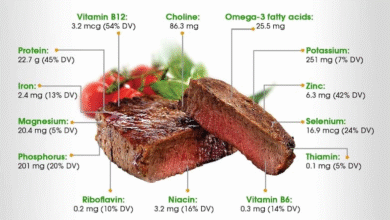Ultra-Processed Foods: A New Federal Report’s Findings

Ultra-Processed Foods are becoming a predominant source of the American diet, with a staggering report from the CDC indicating that over half of daily caloric intake for many adults and children comes from these highly processed products. In fact, many Americans derive approximately 53% of their total calories from ultra-processed foods, which include deeply flavored items such as burgers, sweetened beverages, and packaged snacks. These foods are characterized by high levels of sugar, unhealthy fats, and additives, all while being low in essential nutrients and dietary fiber. Alarmingly, research has linked the consumption of ultra-processed foods to significant health risks, including cardiovascular diseases and increased mortality rates. As the CDC report highlights, the prevalence of ultra-processed food consumption raises critical concerns about U.S. nutrition and public health policies, prompting calls for deeper investigation and clearer definitions in our food supply.
Often referred to as convenience foods, the concept of ultra-processed foods encapsulates a range of products engineered for maximum flavor and shelf life, but lacking in nutritional value. These include familiar staples like fast food items, sugary snacks, and instant meals that contribute heavily to dietary intake. The growing reliance on these convenient but calorie-dense foods is reshaping eating habits across the United States, particularly among the youth. Reports, such as the one released by the CDC, have underscored the implications of heavy reliance on these highly manufactured food items, linking them to various health issues. As experts in public health push for clearer food classifications, understanding the nuances of ultra-processed foods becomes crucial in tackling the ongoing health crises associated with them.
Understanding Ultra-Processed Foods and Their Prevalence
Ultra-processed foods have become a staple in the American diet, contributing significantly to the daily caloric intake. According to a report by the CDC, as of August 2023, Americans consume over half of their daily calories from these types of foods. This category includes popular items like burgers, sweetened beverages, and savory snacks, which are not only convenient but also highly palatable. This dietary shift has led to concerns about nutrition, given that ultra-processed foods are typically low in essential nutrients and high in unhealthy components such as sugars, unhealthy fats, and salt.
The trend is particularly alarming among younger demographics, where nearly 62% of calories consumed come from ultra-processed sources. The consequence of such high consumption rates has raised red flags regarding the long-term health implications, including the risk of obesity, diabetes, and cardiovascular diseases. With burgers and sandwiches being the largest contributors to their caloric intake, it is crucial to assess the overall effects of ultra-processed food habits on the youth’s health.
Frequently Asked Questions
What are ultra-processed foods and why should we be concerned about them?
Ultra-processed foods are industrially formulated foods that typically contain additives like preservatives, sweeteners, and artificial flavors, and very few or no whole food ingredients. Concerns arise because they are high in calories and low in nutritional value, often contributing significantly to caloric intake in the U.S. population, thereby increasing health risks such as obesity, cardiovascular diseases, and all-cause mortality.
How many calories do Americans consume from ultra-processed foods according to recent reports?
Recent reports from the CDC indicate that Americans consume over 50% of their daily calories from ultra-processed foods. Specifically, youth aged 1-18 years obtained approximately 61.9% of their daily calories from these foods, while adults sourced about 53.0% of their calories from ultra-processed foods.
What are the health risks associated with the consumption of ultra-processed foods?
The health risks of ultra-processed foods include increased likelihood of obesity, cardiovascular disease, and all-cause mortality. These items are often high in unhealthy fats, sugars, and salt, and low in dietary fiber, contributing to poor health outcomes.
What types of foods are classified as ultra-processed, and which contribute most to caloric intake?
Common ultra-processed foods include sandwiches, burgers, sweet bakery products, savory snacks, pizza, and sweetened beverages. According to the CDC, among youth, the top sources of calories from ultra-processed foods include sandwiches (7.6%), sweet bakery products (6.3%), and pizza (4.7%). For adults, sandwiches also ranked highest at 8.6%.
What has the recent CDC report indicated about trends in ultra-processed food consumption?
The CDC report noted a slight decline in ultra-processed food consumption over the past decade. Adult intake decreased from approximately 56% in 2013-2014, while children’s consumption dropped from nearly 66% in 2017-2018, indicating a potential positive trend in dietary choices.
Why is there a need for a uniform definition of ultra-processed foods in the U.S.?
Health officials, including those from the USDA and FDA, have expressed the need for a cohesive definition of ultra-processed foods to better assess their impact on health. This is crucial to guide dietary regulations and public health policies, as understanding what constitutes ultra-processed foods can help target interventions effectively.
How does low-income status influence the consumption of ultra-processed foods in the U.S.?
According to findings, low-income adults tend to consume higher quantities of ultra-processed foods compared to their higher-income counterparts. This disparity highlights the intersection of socioeconomic status and diet quality, where accessibility and affordability of healthy food options can significantly impact dietary choices.
| Key Points |
|---|
| Most Americans derive over half of their daily calories from ultra-processed foods. |
| American youth consume 61.9% and adults consume 53.0% of their daily calories from ultra-processed foods (Aug 2021 – Aug 2023). |
| Ultra-processed foods are hyperpalatable, energy-dense, low in dietary fiber, and high in salt, sweeteners, and unhealthy fats. |
| Consumption is linked to higher risks of cardiovascular disease and all-cause mortality. |
| Low-income adults consume more ultra-processed foods than higher-income individuals. |
| Total calorie intake from ultra-processed foods has slightly decreased in the past decade. |
| Top sources of calories among youth: sandwiches (7.6%), sweet bakery products (6.3%), savory snacks (4.9%), pizza (4.7%), sweetened beverages (3.9%). |
| Top sources of calories among adults: sandwiches (8.6%), sweet bakery products (5.2%), sweetened beverages (4.4%), savory snacks (3.4%), breads/rolls/tortillas (3.1%). |
| Health officials are reconsidering definitions of ultra-processed foods to better assess health impacts. |
Summary
Ultra-Processed Foods have become a significant part of the American diet, with alarming statistics revealing that the majority of caloric intake for both youth and adults comes from these food sources. This trend prompts critical health concerns, highlighting the need for both awareness and potential policy changes to redefine and regulate ultra-processed products more effectively.




